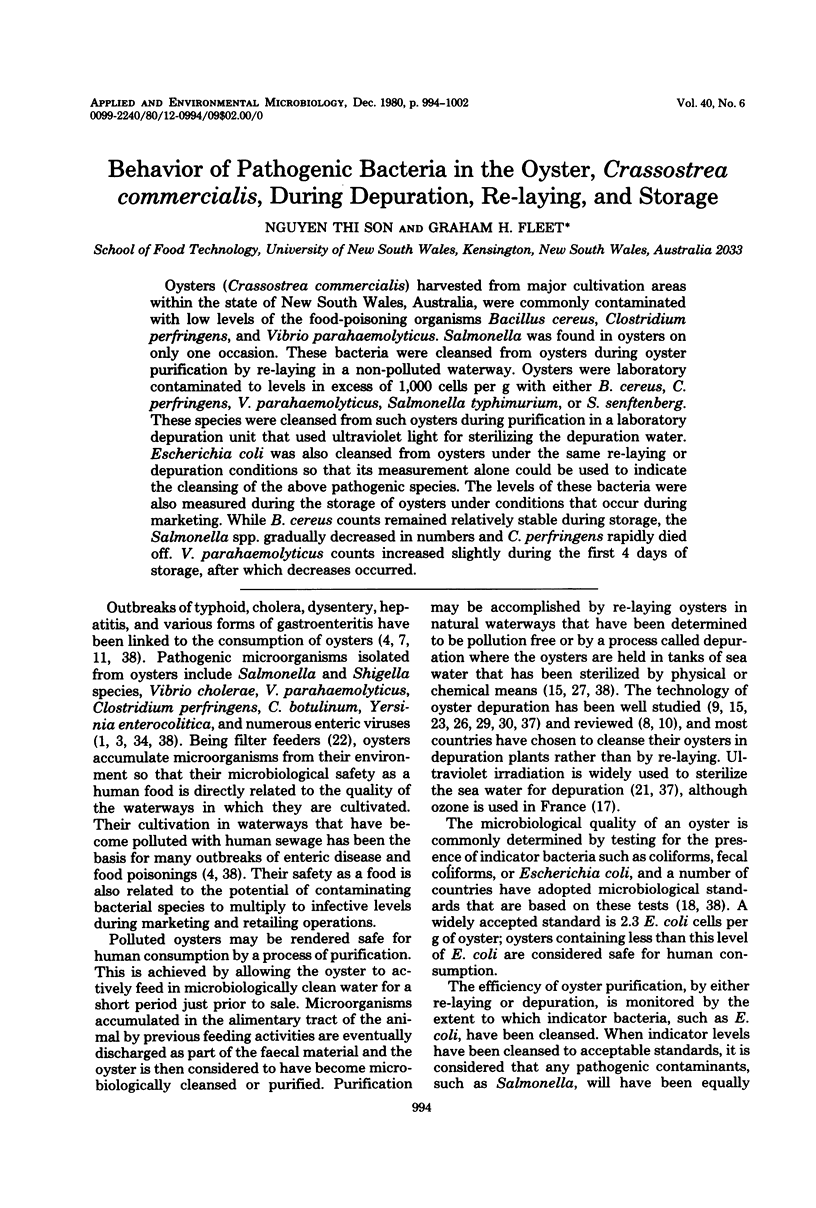Abstract
Oysters (Crassostrea commercials) harvested from major cultivation areas within the state of New South Wales, Australia, were commonly contaminated with low levels of the food-poisoning organisms Bacillus cereus, Clostridium perfringens, and Vibrio parahaemolyticus. Salmonella was found in oysters on only one occasion. These bacteria were cleansed from oysters during oyster purification by re-laying in a non-polluted waterway. Oysters were laboratory contaminated to levels in excess 1,000 cells per g with either B. cereus, C. perfringens, V. parahaemolyticus, Salmonella typhimurium, or S. senftenberg. These species were cleansed from such oysters during purification in a laboratory depuration unit that used ultraviolet light for sterilizing the depuration water. Escherichia coli was also cleansed from oysters under the same re-laying or depuration conditions so that its measurement alone could be used to indicate the cleansing of the above pathogenic species. The levels of these bacteria were also measured during the storage of oysters under conditions that occur during marketing. While B. cereus counts remained relatively stable during storage, the Salmonella spp. gradually decreased in numbers and C. perfringens rapidly died off. V. parahaemolyticus counts increased slightly during the first 4 days of storage, after which decreases occurred.
Full text
PDF








Selected References
These references are in PubMed. This may not be the complete list of references from this article.
- Ayres P. A. The quantitative bacteriology of some commercial bivalve shellfish entering British markets. J Hyg (Lond) 1975 Jun;74(3):431–440. doi: 10.1017/s0022172400046945. [DOI] [PMC free article] [PubMed] [Google Scholar]
- Barrow G. I. Microbiological and other harzards from seafoods with special reference to Vibrio parahaemolyticus. Postgrad Med J. 1974 Oct;50(588):612–619. doi: 10.1136/pgmj.50.588.612. [DOI] [PMC free article] [PubMed] [Google Scholar]
- COLWELL R. R., LISTON J. Microbiology of shellfish. Bacteriological study of the natural flora of Pacific oysters (Crassostrea gigas). Appl Microbiol. 1960 Mar;8:104–109. doi: 10.1128/am.8.2.104-109.1960. [DOI] [PMC free article] [PubMed] [Google Scholar]
- Earampamoorthy S., Koff R. S. Health hazards of bivalve-mollusk ingestion. Ann Intern Med. 1975 Jul;83(1):107–110. doi: 10.7326/0003-4819-83-1-107. [DOI] [PubMed] [Google Scholar]
- Janssen W. A. Oysters: retention and excretion of three types of human waterborne disease bacteria. Health Lab Sci. 1974 Jan;11(1):20–24. [PubMed] [Google Scholar]
- Johnson W. G., Jr, Salinger A. C., King W. C. Survival of Vibrio parahaemolyticus in oyster shellstock at two different storage temperatures. Appl Microbiol. 1973 Jul;26(1):122–123. doi: 10.1128/am.26.1.122-123.1973. [DOI] [PMC free article] [PubMed] [Google Scholar]
- KELLY C. B., ARCISZ W. Survival of enteric organisms in shellfish. Public Health Rep. 1954 Dec;69(12):1205–1210. [PMC free article] [PubMed] [Google Scholar]
- KELLY C. B. Disinfection of sea water by ultraviolet radiation. Am J Public Health Nations Health. 1961 Nov;51:1670–1680. doi: 10.2105/ajph.51.11.1670. [DOI] [PMC free article] [PubMed] [Google Scholar]
- Matches J. R., Liston J., Curran D. Clostridium perfringens in the environment. Appl Microbiol. 1974 Oct;28(4):655–660. doi: 10.1128/am.28.4.655-660.1974. [DOI] [PMC free article] [PubMed] [Google Scholar]
- Slanetz L. W., Bartley C. H., Stanley K. W. Coliforms, fecal streptococci and Salmonella in seawater and shellfish. Health Lab Sci. 1968 Apr;5(2):66–78. [PubMed] [Google Scholar]
- Vasconcelos G. J., Lee J. S. Microbial flora of Pacific oysters (Crassostrea gigas) subjected to ultraviolet-irradiated seawater. Appl Microbiol. 1972 Jan;23(1):11–16. doi: 10.1128/am.23.1.11-16.1972. [DOI] [PMC free article] [PubMed] [Google Scholar]


